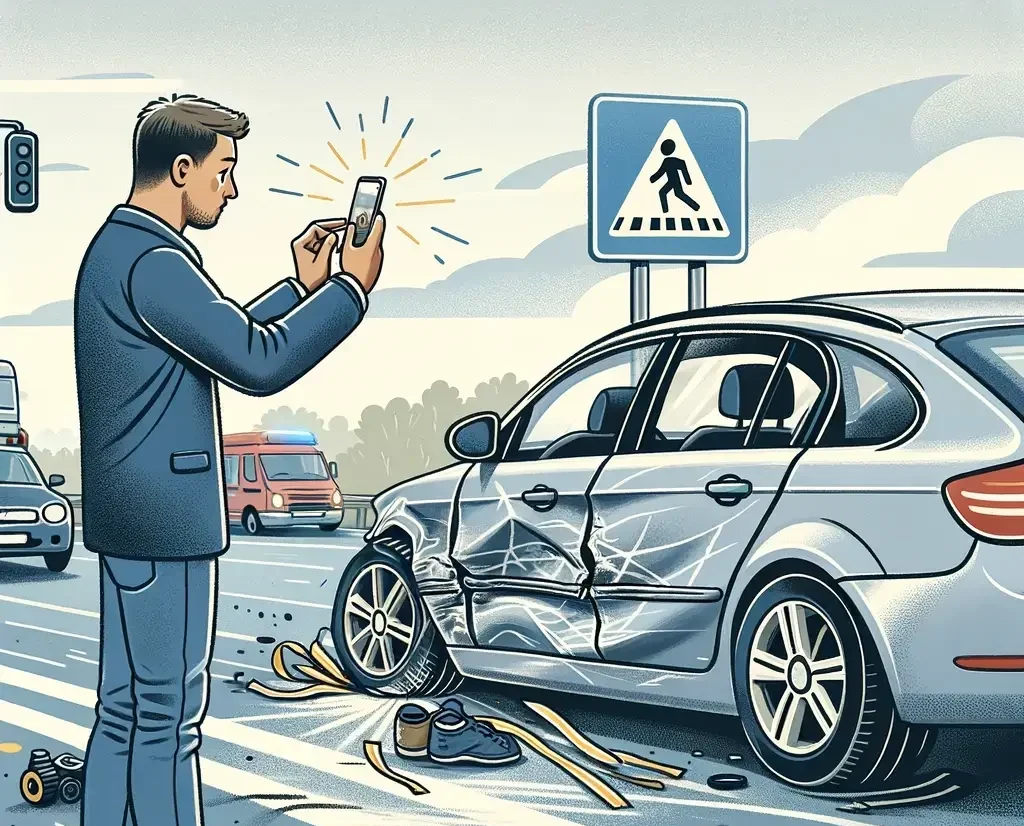Taking effective auto accident pictures during the chaos and confusion is not easy. Many drivers have not prepared to capture the information that will be critical later.
Undeniable photos are an art and a science. A checklist can get you started, but there are other items that you might overlook.
Whether you have just been in an accident or want to prepare, we have valuable advice to share. Discover what you should prioritize below and ask us for a referral to legal help!
The Importance of Auto Accident Pictures
Photographs cut through the confusion and offer a clear depiction of events because they capture more than the damage. These images provide context, conditions, and vital details often overlooked by memory. As a result, they are often central to any insurance claim or legal battle.
Furthermore, the utility goes beyond their immediate use. They streamline dialogue and eliminate ambiguities for insurance adjusters, attorneys, and law enforcement.
What to Capture: A Comprehensive Checklist
Overall Scene
Capturing all of an auto accident scene is paramount to creating a complete narrative. Wide-angle shots provide valuable context, detailing vehicle positioning and environmental factors.
Furthermore, these scenes capture seemingly minor details that may prove pivotal, such as traffic signals. Each piece contributes to understanding the event, distinguishing between normal conditions and oddities.
Vehicle Damages
Each dent, scratch, and shattered piece of glass tells a part of the story. Precision in documenting vehicle damages chronicles the intensity and location of each impact. Close-up photographs are compelling evidence of the severity, leaving no room for speculation.
Multiple angles and perspectives are crucial to provide a holistic view. Include surrounding context, like the vehicle’s position near other objects or landmarks. These pieces add another layer of undeniable evidence, reinforcing the credibility of the documentation.
Environmental and Road Conditions
An auto accident is a complex interplay of factors that can sway the course of events. Capturing this backdrop is crucial for understanding the accident’s dynamics. Whether it’s the sun casting long shadows, rain slicking the streets, or unexpected obstacles, these conditions hold vital clues.
Moreover, road conditions can significantly shape the accident’s narrative. They are evidence of potential negligence or hazards that may alter perceptions of fault.
Injuries
Documenting injuries presents a raw depiction of the physical toll from the collision. It bridges the divide between mechanical damage and human suffering.
Photographs of injuries serve as a reminder of the urgency for a fair resolution. They are powerful tools in shaping perceptions of severity for insurers and legal entities.
Contributing Factors
Auto accidents can have subtle pieces that reveal relevant factors. Photographs capturing these nuances can give your attorney substantial details to submit to the court. Obscured road signs, malfunctioning traffic lights, or unexpected road obstacles could shift fault and responsibility.
Furthermore, these photographs advocate for preventative measures and improvements. They spotlight areas for road safety enhancement through clearer signage, improved maintenance, or enhanced traffic signals.
Witnesses and Participants
Individuals add a distinct layer to the unfolding story. Photographing witnesses and asking them to provide statements humanizes the process. Their validation of your assertions anchors the gritty reality of what you experienced.
Meanwhile, for witnesses, their inclusion in photographs underscores their significance. These pictures bridge personal experiences and add depth to the narrative.
Tips for Taking Effective Pictures
Undeniable auto accident pictures hinge on meticulous attention to detail. Each shot must capture the truth with deliberate composition, clarity, and context. A few tips everyone should follow include:
- Use natural light or flash for optimal visibility
- Find varying angles to reveal critical details
- Avoid digital alterations to preserve authenticity
- Include identifiable landmarks
- Utilize timestamps
How to Organize and Store Your Pictures
Organizing and safeguarding auto accident pictures is easy to take for granted. Do more than snap photos. It is in your best interests to ensure easy access and use when needed. Proper organization, whether by date or subject matter, simplifies retrieval and presents a coherent narrative.
Secure storage is equally vital. You can lose photos due to hardware failure or data corruption. Therefore, backing up pictures across multiple platforms ensures their integrity.
Ask a Local Attorney About Your Auto Accident Pictures
Your photos create a foundation of truth for your claims. Every motorist should take the time to know how to capture evidence that speaks volumes. Little else can empower you as much to assert your rights and seek the justice you deserve.
However, the journey doesn’t end with capturing the perfect set of photographs. The next vital step is to enlist the expertise of an auto accident attorney.
Take the next step today by completing this form or calling (866) 345-6784!

